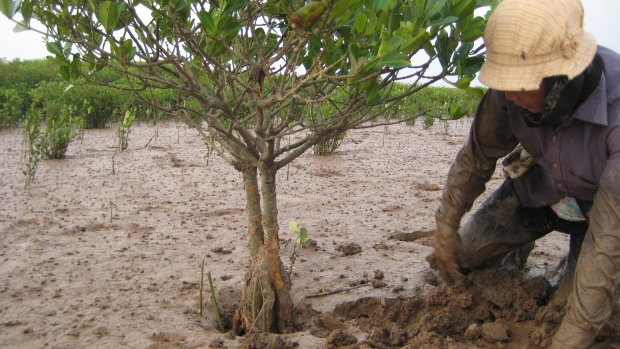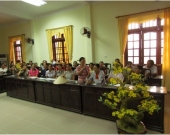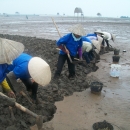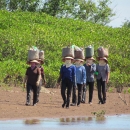Grants :: Small Grant Facilities :: Sustainable use of mangrove resources to benefit poor women through a co-management pilot in the core zone of Xuan Thuy National Park, Vietnam
Sustainable use of mangrove resources to benefit poor women through a co-management pilot in the core zone of Xuan Thuy National Park, Vietnam

Women manually collecting aquatic resources in Xuan Thuy Nat ... , Nam Dinh, Viet Nam © Xuan Thuy National Park, 2012
Objectives
The project "Sustainable use of mangrove resources to benefit poor women through a co-management pilot in the core zone of Xuan Thuy national park" aims to develop and integrate a model of mangrove co-management into the XTNP management system for protection of about 1,000-hectare area on Lu islet, as well as benefit sharing with the poor fishing-women.
Background
Xuan Thuy National Park is located at the estuary of the Red River in Nam Dinh province, about 150 km south-east of Hanoi, Vietnam. The area was declared the country’s first Ramsar site by the Bureau of the Convention on Wetlands of International Importance in January 1989. Since then, the Government of Vietnam has worked to preserve the value of this area through the establishment of new laws, policies and investments. In 2003, it was upgraded from its status as a nature reserve and approved as a national park by the Prime Minister, and was also included as part of the Red River Delta World Biosphere Heritage Site by UNESCO in October 2004.
XTNP is a vast wetland, which covers an area of about 7,100 hectares of the core zone, and 8,000 hectares of the buffer zone. Endowed with rich alluviums, the park boasts a unique wetland habitat with diversified species of flora and fauna, especially migratory birds. XTNP is the home for a total of 219 bird species belonging to 41 families and 13 orders, in which nine have been recorded as endangered species in the Red Data Book. During the high migratory season, XTNP can attract 30–40 thousand birds, and hundreds of bird watchers from all over the world come to the site.
XTNP is divided into core zone and buffer zone, in accordance to National laws designated for national parks in Vietnam. Management guidelines were specifically made for each zone, so that the core zone is a strictly protected area without any human activity allowed; and the buffer zone, adjacent to the core zone, acts as a transition area where activities are regulated to restrict and reduce adverse human impacts on the park.
Current activities in the park do not comply with the regulations and laws. Hundreds of people consistently exploit the natural resources (mostly aquatic animals) under the mangrove canopy in the core zone. Local people rely heavily on the wetlands for their livelihoods and income. Consequently, the management board of XTNP faces a dilemma. They can neither officially accept the presence of people in the restricted area, nor strictly follow the official laws barring human activity in the core zone. Thus, the park officers and authorities cannot implement any permanent actions to solve conflicts among different fisher groups, ask for their cooperation to protect the mangroves, or request a stop to destructive fishing methods. As a result, the mangrove ecosystem is degraded, the park has lost effective control, and the local people have become more vulnerable due to decreasing natural resources.
In these circumstances, the park's management board proposed to pilot new co-management policies and mechanisms for protecting the mangroves in the core zone. This pilot project was based on good experiences in co-management mechanisms for mangroves in the buffer zone as well as clam nursery areas, at the mouth of the Red River. In these co-management models, the park is the key stakeholder, bringing various other stakeholders on board and officially recognizing human needs and livelihood requirements in these protected areas.
http://www.youtube.com/watch?v=cGezdJPfMxI (Part 1)
http://www.youtube.com/watch?v=KXHRzoXaCJY&feature=channel&list=UL (Part 2)
Target beneficiaries
- At local level, 500 women were targeted so as to empower them to participate in policy making processes, receive financial support to improve their household sized livelihood activities through the Local Initiative Fund (LIF) and help enhance their awareness of mangroves and sustainable fishing methods.
- At the regional level, eleven authorized institutions were supported by the project as the co-management mechanism would provide a platform for them to cooperate, work against unsustainable exploitation of natural resources and fishery under the mangrove canopy
- At the national level, success in the co-management pilot in the core zone of XTNP acted as a concrete case-study for other nature reserves, national parks and wetland sites in particular.
Outputs
Output 1: The existing co-management model in the buffer zone of XTNP is reviewed and improved to fit into the core zone.
Output 2: The improved co-management model adapted and pilot tested in the core zone of XTNP.
Accomplishments and challenges
- Enhanced participation of local communities and stakeholders to harmonize natural resources and community development policies:
Nearly 200 local people, most of whom were women, participated in pilot policy making and monitoring of policy enforcement.The co-management policy has been legalized, which will help reduce conflicts among local groups and park staff. The park now officially accepts the presence of fisher women in the core zone by a mutual agreement between the park and each local individual with the endorsement of the local government. They are also involved in preparing and enforcing regulations over what species can be collected, how (no mechanical devices), where, and when (no harvesting in reproductive season). By working with the fisher women, the park was able to provide oversight of resource use activities through a peer monitoring system of self-management teams. In addition to being encouraged to practice sustainable fishing methods, fisher women were entitled to small loans from the LIF to improve livelihoods as a way to reduce pressure on natural resources.
- Contribution to policy making and law enforcement:
At the local level; local authorities, functional agencies and communities closely collaborated in formulating and enforcing regulations in order to reduce non-sustainable exploitation of mangrove resources.
In February 2012, the Prime Minister issued 'Decision 126' on piloting benefit sharing in the management, protection and sustainable development of protected areas. With its experience in piloting co-management mechanisms, XTNP was chosen as one of two sites to implement the decision. In line with the decision, the park must implement the following five components:
- Sustainable use of clam seed bed resources in frequently flooded areas in the Red River Estuary and around Lu and Ngan Islands.
- Sustainable local community use of aquatic resources inside the mangrove forests in the core zone of the park.
- Community-based mangrove management model in the park's buffer zone in Giao An, Giao Lac,and Giao Xuan Communes.
- Sustainable use of the clam culture areas while still protecting important bird areas in the ecological restoration zone on Lu Island.
- Sustainable collection of medical plants in the Casuarinas forests on Lu Island.
This SGF project fits in the pilot implementation of Component B of Decision 126. Therefore, at the national level, the success of the pilot co-management policy in the core zone of XTNP provided a solid basis for other protected areas and national parks to replicate a community-based management model to wisely use mangrove resources.
- Change in the awareness and actions of the local community:
According to the local fisher women, public awareness of local people, especially those directly collecting aquatic resources from the wild, has improved remarkably. This has been achieved by disseminating information through a variety of communication channels; including 15 local public speakers, 10 dialogues with fisher women, production and dissemination of 500 handbooks and 2,000 leaflets on wise use of mangrove resources and sustainable fishing techniques. Change in local community's awareness has resulted into change in their actions. It was reported by the monitoring committee that there has been no violation of regulations set forth by the project.
- Strengthened capacity of both local community and national park officers:
The park initiated the LIF fund and then transferred it to the Women's Union commune for further management. The head of the self management team is a member of the fund management team who, based on the votes of local fisher women, select households to give loans.The project also created opportunities for about 20 officers of XTNP to become familiar with the co-management approach as well as to improve their skills in communicating and interacting with local people. For a long time, the park applied a top down management approach- therefore, fisher women often avoided meeting the park's staff because they were afraid that what was collected from the core zone of the park would be confiscated.To initiate the dialogue process, park officials communicated the co-management model and how it would bring benefits to them. This resulted in a select group of women becoming active focal points for communication between the park authorities and other local fisher women.
Contributions to cross-cutting themes
Gender: The project was targeted more than 500 women working in the mangroves, who participated in pilot policy formation as well as livelihood improvement. Women were provided equal opportunities in consultative dialogues to initiate, develop and implement the mangrove co-management policy. Women were recognized as the primary group to implement and monitor the policy. In terms of livelihood improvement, women were the distinguished members to form a Women Fishing Group, who then received different types of support to increase livelihood capital capacity and awareness.
Communications: The project conducted various communication activities to increase awareness of the mangrove resources and sustainable fishing activities for Women Fishing Group, women union and other relevant stakeholders through dialogues, news on local commune's public speaker, leaflets.
Lessons Learned
While the capacity of XTNP Management Board is not sufficient to control a vast area of wetland resources, the pilot policy has proved that enhancing local community ownership results in positive change awareness and can help shift behavior towards improved management of coastal resources. Selected lessons and recommendations are listed below:
- Women initially thought that there were only two options: exploitation of natural resources in the usual manner (exploitative), or complete ban (no exploitation of resources allowed). The women who were initially resistant to the project, because they thought that they would be completely banned from resource exploitation. However, they learned that there is a win-win solution under which they could still exploit resources, but in a more sustainable manner while also gaining access to other benefits such as the fund for livelihood development.
- Fisherwomen's sources of livelihood and family food security depend heavily on aquatic resources. As such, they should be the most active advocates in protecting mangroves, once they are brought on board and empowered.
- "Co-management is not clearly defined, even by the Ministry of Agriculture and Rural Development (MARD). XTNP staff believe what they have achieved so far ison-the-ground co-management and that the local people are empowered with rights and obligations/ responsibilities. Co-management means not only the participation of the community, but also giving rights to local people in making decisions and managing and monitoring activities. It was suggested that the project should analyze mechanisms for the allocation of property rights and to ensure that local community has the capacity to manage resources under this model.
- The project has applied an integrated approach in benefit sharing and wise use of wetland resources of the park following the recommendations of the Ramsar Convention. However, there was concem about allowing people to collect resources in the core zone of the park. Further work is needed to ensure that pilot regulations in XTNP are in accordance with national law, or can help influence and improve national laws to better reflect-on-the-ground management requirements. In addition, it is necessary to ensure that benefits sharing not only requires users to pay a small fee to access the core zone, but also follow sustainable practices. Although other national parks do not allow exploitation in the core zone, both MARD and Nam Dinh Provincial People's Committee approved XTNP to pilot such a model of benefits sharing from clam seed beds at the mouth of the Red River, which falls within the core zone of XTNP. However, even wise use of resources in the core zone, including limiting fishing to simple gear, can still negatively impact the core zone. The project should have strict controls and a long term monitoring system should be implemented (e.g., tracking total catch per unit time) to illustrate the project's impacts on reducing over exploitation of the park's natural resources.
- To sustain the project results and stop illegal exploitation in the core zone of the park, the project has set up a community-based monitoring system. The park is now proposing to collect a fee of VND 50,000 (USD 2) per collector, per month to cover the operational costs of the monitoring committee and to contribute to the livelihood fund. Ten percent of the revenue is to cover costs of monitoring activities. Based on Decision No. 126 of the Prime Minister, the Park is allowed to collect and manage this fee. There is a detailed regulation on how to spend this money. The proposal process should involve and consult with the local community and should be followed up at a later step in order to have the fee collection approved and enforced.
Related News
Working with fisherwomen in Xuan Thuy National Park
Xuan Thuy National Park, Viet Nam 22 Mar 2013
Country: Viet Nam
Topic: Civil Society Engagement, Capacity Building, Community Resilence ...
Every day, hundreds of local fisherwomen enter the mangrove forest in Xuan Thuy National Park to collect shells, mollusks, crabs, and other aquatic products. Although the law prohibits any kind of resource extraction in the core zone, the poor women...
Project Facts
Country
Location
Xuan Thuy National Park, Nam Dinh province, Vietnam
Topic
Duration
1st Oct 2011 to 28th Feb 2013
MFF Grant Amount
VND373,050,000
Implementing Partner
Mr. Nguyen Viet Cach - Director
Xuan Thuy National Park
Giao Thien Commune, Giao Thuy District, Nam Dinh Province, Vietnam
Email: contact@vuonquocgiaxuanthuy.org.vn
Website: Xuan Thuy National Park




